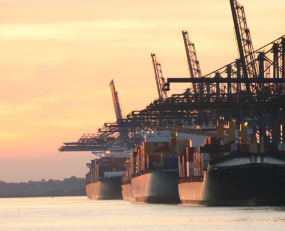
If getting McDonald’s Milkshakes, Nando’s chicken and Dairy products are a problem, at least in the UK now; could the Xmas gifts be far behind? It is not just in the UK, every Industry in most developed markets is experiencing acute delivery and supply chain challenges. While the challenges in the UK may be compounded by the post-Brexit disruptions, the supply chain and logistics issues bubbling up elsewhere along with inflation scares, covid closures caused by new variants, limited vaccination, worker, and chip shortages are all additives that are leading towards a stolen Christmas.
Ben Franklin’s quote “For want of a nail the kingdom was lost”, is apt for these times when it is not just Christmas, but economic growth is being lost because of some logistical challenges!
Factories in Vietnam, Ports in China, apparel manufactures in Bangladesh, Sri Lanka are closed due to covid outbreaks. Transit times from Asia to the US has almost doubled and the average wait time for container ships entering the ports of Los Angeles & Long Beach to unload their cargo (which account for a third of the US Imports) is over 7 days – in normal times it is usually between 0 and 3 days. Beyond that, the truck and rail capacity at the terminals are capacity constrained and it takes another week for the containers to move inland. Supply chain bottlenecks pushed factory activity in Germany to its lowest level in six months.
Peak ocean shipping season for Xmas is between Aug & early October, but the demand never went away since last fall. With a shortage of containers, not to mention product itself, the per container transport charges from Asia to the US have almost tripled and even at those prices, a small retailer may be out of luck if their goods are not in transit, forget about placing the order now for ocean transport in time for Xmas. Large US Retailers such as Walmart and Home Depot are chartering ships to ensure capacity but also inventory impacted by supply chain constraints. With ship leasing firms reporting an increasing number of charter agreements, the assumption is that Christmas dependent retailers, including toy manufacturers, are doing the same to ensure product availability.
These delays and product shortages, a boon for air cargo and freight companies resulting in increasing costs, will pinch the wallets of Christmas shoppers – so much for inflation being transitory. With most aircraft still grounded and limited or no international travel, the belly cargo space capacity has also vanished making air freight much more expensive. Early during the pandemic, some airlines removed passenger seats to transport more cargo. The current situation presents an opportunity for more International Airlines to resuscitate their routes on an as-needed basis to offset some of the revenue loss with parcels as passengers.
While the average consumer is seeing the shortages at the retail level, the damage was done upstream more than 16 months ago. Much like the spread of the delta variant, the supply chain challenges that manifested itself in March 2020 with PPE, Toilet paper, disinfectants and products that home-bound consumers ordered in boatloads has spread wide and deep across all sectors and industries.
As Warren Buffett said, “Only when the tide goes out do you discover who’s been swimming naked”. Arguably, it was the pandemic that exposed the vulnerabilities of businesses with “extremely efficient supply chains” and impacting the suppliers and consumers with any break in the supply chain. Those businesses that were advised that any inventory was inefficient and that the “I” word was bad will need to radically re-think this concept. When you have tens of firms with millions of unfinished product inventory in their warehouses, waiting for that one part to make it a finished good ready for shipping, it is time to reconsider.
Whether it is the Pandemic, the effects of Climate Change or even a Ship being stuck in the Suez Canal disruptions will become commonplace. Near-shoring must be a considered strategy for any business, especially if you do not have the market power to negotiate ocean/air freight rates. Surely there are more cost-effective producers/distributors of components for your products closer to the consumers of these goods? Of course, it is not a simple proposition, and the strategy will vary by sector. However, the average US consumer, who is used to everyday low prices, is in for a rude shock as price increases will be the rule rather than the exception.
As I started putting pen to paper, Walmart announced that it is hiring 20,000 workers for its supply chain operations – it is primarily for the distribution and delivery business, in other words, e-commerce logistics – with average wages closer to $20/hour. Along with the hiring, Walmart is also opening its in-house delivery platform Spark Driver so other gig workers can leverage it to increase their delivery density with the Walmart GoLocal program. Of course, it is addressing one of the most challenging aspects of e-commerce – costs associated with last-mile delivery. (Full Disclosure: I worked at UPS for 29 years before retiring early).
The challenges in the supply chain from source to consumption are never-ending. A few things to proactively think about prior to a product launch or much before it reaches crisis status, include:
To ensure its current viability and better yet, to be prepared for your peak sales season it would be advisable to continually update and revise your supply chain checklist every few months.
I hope to revisit the topic of e-commerce logistics, especially in emerging markets, soon.
Source: Transport Intelligence, September 7 2021
Author: Raghu Ramachandran
This is a guest post from Raghu Ramachandran of 13 Colony Global LLC. You can contact Raghu at [email protected]